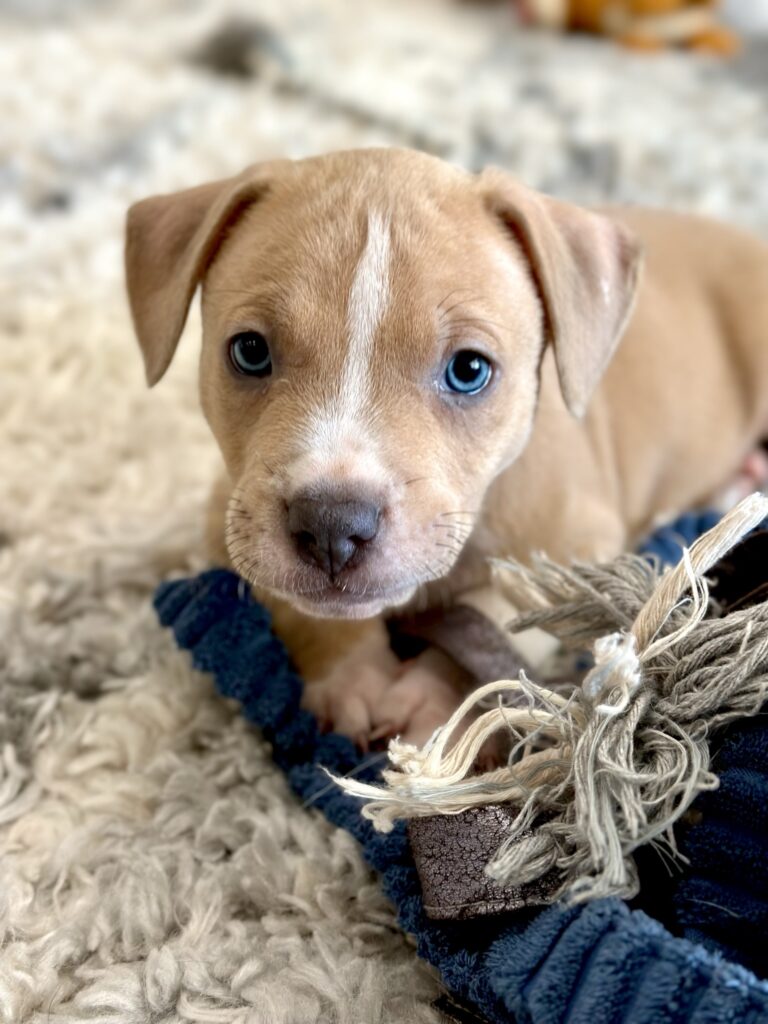The first time I fostered, a lot of things went wrong, and it was, largely, unenjoyable. There was something about it, though, that still made me want to try it again…
I was able to beg and persuade my husband to let me try fostering, and he relented but said “but I’m not lifting a finger to help.” Spoiler alert: he had to lift MANY fingers to help.
In June 2022, I matched to foster two pups, Bamba and Ozzie, from a Rainforest Cafe-themed litter. They were older pups–10 weeks–and the commitment was just two weeks, which seemed totally doable! After all, I had successfully raised two puppies from eight-weeks old.
We thought we had puppy-proofed the yard, but alas, the drainage holes in our fencing were big enough for the foster pups to squeeze through. The first morning I had them, one squeezed through, and I had to run around to the other side of the fence to grab him. I was successful, but his brother then wormed his way through the same drainage hole so I had to grab the second one.
This is really where everything went downhill… literally. I tripped on uneven grass and fell, and while I managed to prevent harm coming from the two furry bundles I was carrying, I broke my hand. So that whole, “not lifting a finger to help” swiftly became my husband doing a good bit of the lifting.

Thankfully, I have a very compassionate and understanding husband who was only half-joking about not helping to begin with, since he helped unload all of the pups’ supplies and crate as soon as I brought them home (and before I broke my hand).
It turns out that fostering 10-week old puppies with a broken hand isn’t easy and kind of limits the fun when you’re worried about how you’re going to get your actual job done with a broken hand! It was quite overwhelming, and despite having puppy-raising experience, I felt underprepared.

It’s truly a surprise that I was game to try again–and I was able to get my husband on board as well–with two six-week old pups, Maleficent and Prince Philip, a few months later. I just knew we had to be missing something from the fostering experience, and I figured that younger pups might be easier and more our speed.
They were a lot easier than the first set of pups as they were younger and spent more time sleeping for the first couple of weeks. My husband and I still found it hard to adjust to the element of chaos and noise puppies bring as two people who worked from home in a normally very, very quiet household, as we felt like every time we made a move, they’d see us and wake up.
We eventually put two and two together and realized that having the puppies set up in the family room was the issue; they DID always see us, and they were always where the “action” was.
It was rewarding to see them go onto their forever homes, and I still get updates on my sweet Prince Philip almost two years later that bring tears to my eyes.

After those two fosters, I started volunteering on-site more often and went four to five times a week in lieu of fostering. I found on-site volunteering significantly more enjoyable, and obviously, my husband was fully on-board with it since it meant he wasn’t involved at all!
It wasn’t until the rescue put out a call for emergency fosters for cleft palate puppies right before New Year’s Eve that everything changed for me and I really fell in love with fostering, where I had it all click into place.
Taking on those newborns that had to be tube-fed opened up a whole new world of fostering for me and paved the way forward in my fostering journey. I fell in love newborn puppies; I love caring for bottle babies, stabilizing medical cases, and supporting the early growth and development of neonates.






